dsc BMW X3 2.5I 2004 E83 Owner's Manual
[x] Cancel search | Manufacturer: BMW, Model Year: 2004, Model line: X3 2.5I, Model: BMW X3 2.5I 2004 E83Pages: 132, PDF Size: 3.62 MB
Page 14 of 132
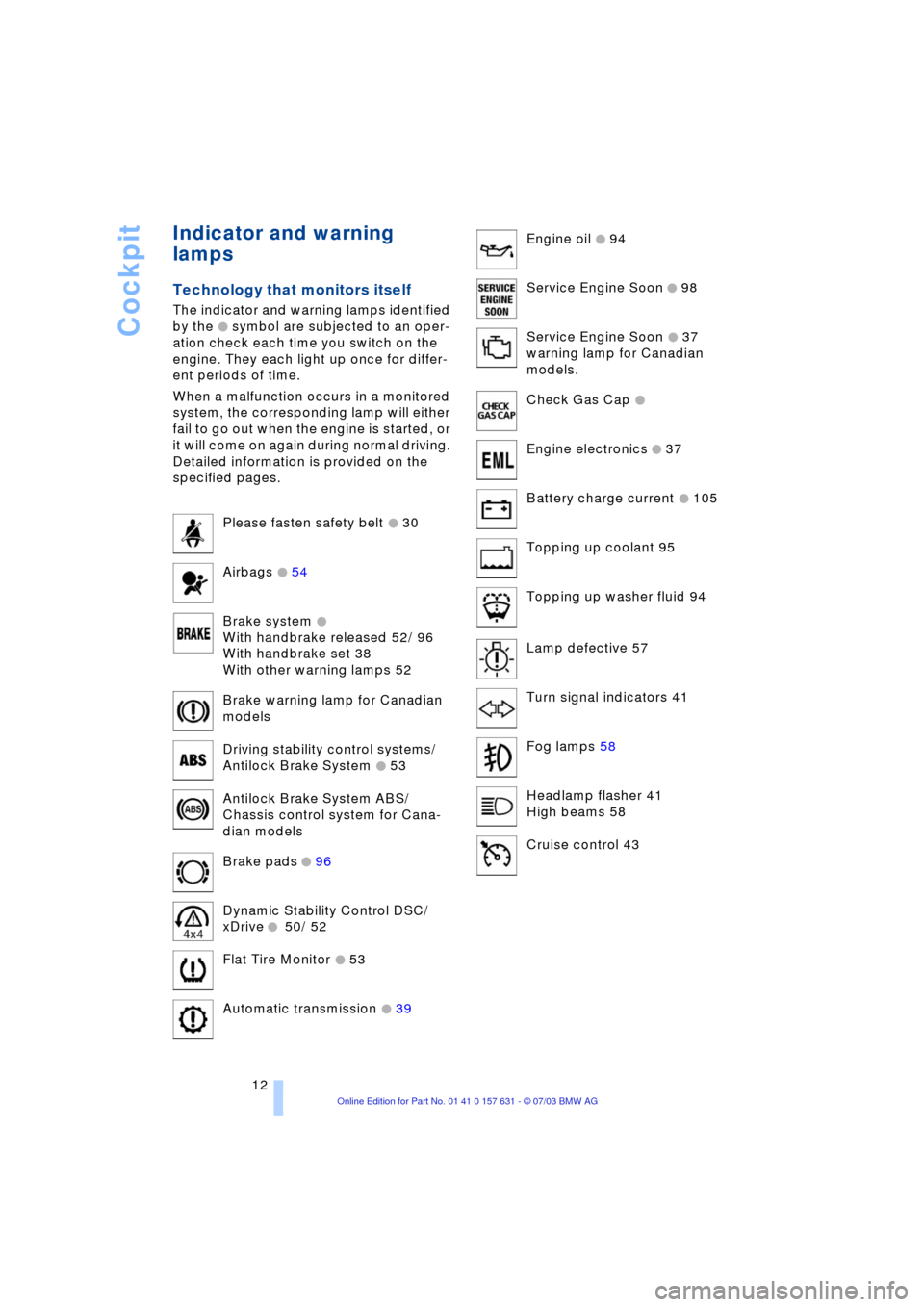
Cockpit
12
Indicator and warning
lamps
Technology that monitors itself
The indicator and warning lamps identified
by the
+ symbol are subjected to an oper-
ation check each time you switch on the
engine. They each light up once for differ-
ent periods of time.
When a malfunction occurs in a monitored
system, the corresponding lamp will either
fail to go out when the engine is started, or
it will come on again during normal driving.
Detailed information is provided on the
specified pages.
Please fasten safety belt
+ 30
Airbags
+ 54
Brake system
+
With handbrake released 52/ 96
With handbrake set 38
With other warning lamps 52
Brake warning lamp for Canadian
models
Driving stability control systems/
Antilock Brake System
+ 53
Antilock Brake System ABS/
Chassis control system for Cana-
dian models
Brake pads
+ 96
Dynamic Stability Control DSC/
xDrive
+ 50/ 52
Flat Tire Monitor
+ 53
Automatic transmission
+ 39
Engine oil + 94
Service Engine Soon
+ 98
Service Engine Soon
+ 37
warning lamp for Canadian
models.
Check Gas Cap
+
Engine electronics + 37
Battery charge current
+ 105
Topping up coolant 95
Topping up washer fluid 94
Lamp defective 57
Turn signal indicators 41
Fog lamps 58
Headlamp flasher 41
High beams 58
Cruise control 43
Page 52 of 132
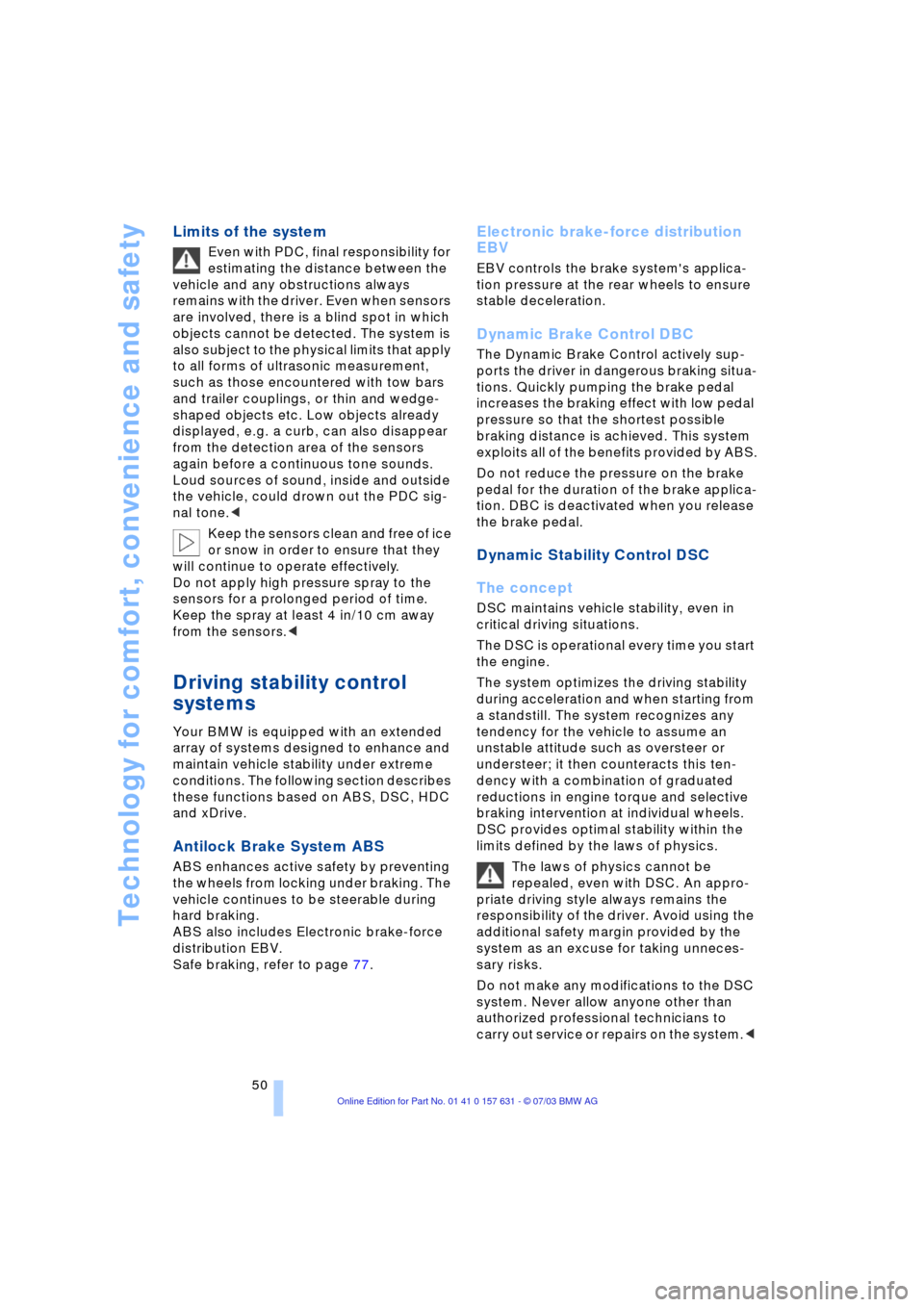
Technology for comfort, convenience and safety
50
Limits of the system
Even with PDC, final responsibility for
estimating the distance between the
vehicle and any obstructions always
remains with the driver. Even when sensors
are involved, there is a blind spot in which
objects cannot be detected. The system is
also subject to the physical limits that apply
to all forms of ultrasonic measurement,
such as those encountered with tow bars
and trailer couplings, or thin and wedge-
shaped objects etc. Low objects already
displayed, e.g. a curb, can also disappear
from the detection area of the sensors
again before a continuous tone sounds.
Loud sources of sound, inside and outside
the vehicle, could drown out the PDC sig-
nal tone.<
Keep the sensors clean and free of ice
or snow in order to ensure that they
will continue to operate effectively.
Do not apply high pressure spray to the
sensors for a prolonged period of time.
Keep the spray at least 4 in/10 cm away
from the sensors.<
Driving stability control
systems
Your BMW is equipped with an extended
array of systems designed to enhance and
maintain vehicle stability under extreme
conditions. The following section describes
these functions based on ABS, DSC, HDC
and xDrive.
Antilock Brake System ABS
ABS enhances active safety by preventing
the wheels from locking under braking. The
vehicle continues to be steerable during
hard braking.
ABS also includes Electronic brake-force
distribution EBV.
Safe braking, refer to page 77.
Electronic brake-force distribution
EBV
EBV controls the brake system's applica-
tion pressure at the rear wheels to ensure
stable deceleration.
Dynamic Brake Control DBC
The Dynamic Brake Control actively sup-
ports the driver in dangerous braking situa-
tions. Quickly pumping the brake pedal
increases the braking effect with low pedal
pressure so that the shortest possible
braking distance is achieved. This system
exploits all of the benefits provided by ABS.
Do not reduce the pressure on the brake
pedal for the duration of the brake applica-
tion. DBC is deactivated when you release
the brake pedal.
Dynamic Stability Control DSC
The concept
DSC maintains vehicle stability, even in
critical driving situations.
The DSC is operational every time you start
the engine.
The system optimizes the driving stability
during acceleration and when starting from
a standstill. The system recognizes any
tendency for the vehicle to assume an
unstable attitude such as oversteer or
understeer; it then counteracts this ten-
dency with a combination of graduated
reductions in engine torque and selective
braking intervention at individual wheels.
DSC provides optimal stability within the
limits defined by the laws of physics.
The laws of physics cannot be
repealed, even with DSC. An appro-
priate driving style always remains the
responsibility of the driver. Avoid using the
additional safety margin provided by the
system as an excuse for taking unneces-
sary risks.
Do not make any modifications to the DSC
system. Never allow anyone other than
authorized professional technicians to
carry out service or repairs on the system.<
Page 53 of 132
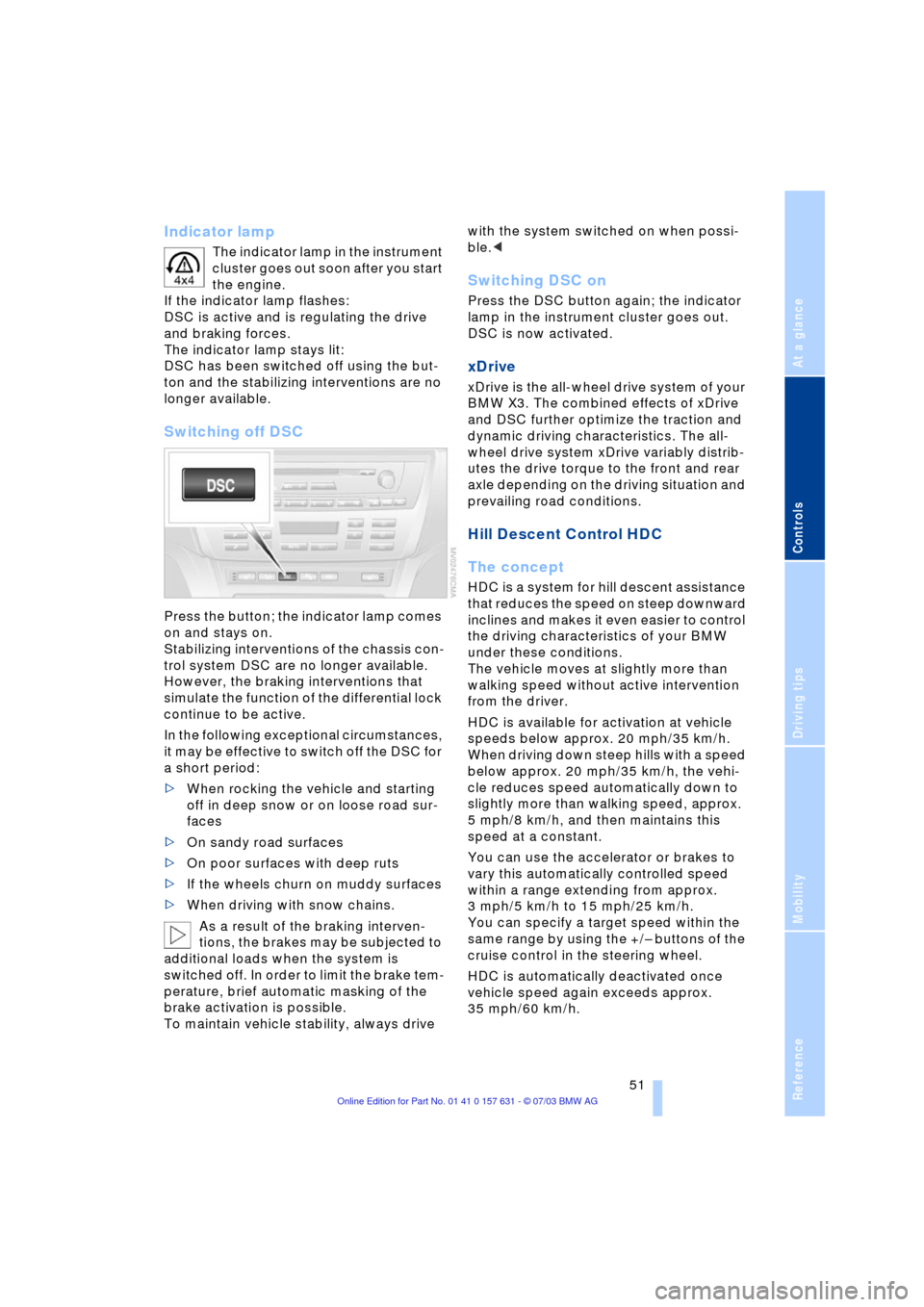
Reference
At a glance
Controls
Driving tips
Mobility
51
Indicator lamp
The indicator lamp in the instrument
cluster goes out soon after you start
the engine.
If the indicator lamp flashes:
DSC is active and is regulating the drive
and braking forces.
The indicator lamp stays lit:
DSC has been switched off using the but-
ton and the stabilizing interventions are no
longer available.
Switching off DSC
Press the button; the indicator lamp comes
on and stays on.
Stabilizing interventions of the chassis con-
trol system DSC are no longer available.
However, the braking interventions that
simulate the function of the differential lock
continue to be active.
In the following exceptional circumstances,
it may be effective to switch off the DSC for
a short period:
>When rocking the vehicle and starting
off in deep snow or on loose road sur-
faces
>On sandy road surfaces
>On poor surfaces with deep ruts
>If the wheels churn on muddy surfaces
>When driving with snow chains.
As a result of the braking interven-
tions, the brakes may be subjected to
additional loads when the system is
switched off. In order to limit the brake tem-
perature, brief automatic masking of the
brake activation is possible.
To maintain vehicle stability, always drive with the system switched on when possi-
ble.<
Switching DSC on
Press the DSC button again; the indicator
lamp in the instrument cluster goes out.
DSC is now activated.
xDrive
xDrive is the all-wheel drive system of your
BMW X3. The combined effects of xDrive
and DSC further optimize the traction and
dynamic driving characteristics. The all-
wheel drive system xDrive variably distrib-
utes the drive torque to the front and rear
axle depending on the driving situation and
prevailing road conditions.
Hill Descent Control HDC
The concept
HDC is a system for hill descent assistance
that reduces the speed on steep downward
inclines and makes it even easier to control
the driving characteristics of your BMW
under these conditions.
The vehicle moves at slightly more than
walking speed without active intervention
from the driver.
HDC is available for activation at vehicle
speeds below approx. 20 mph/35 km/h.
When driving down steep hills with a speed
below approx. 20 mph/35 km/h, the vehi-
cle reduces speed automatically down to
slightly more than walking speed, approx.
5 mph/8 km/h, and then maintains this
speed at a constant.
You can use the accelerator or brakes to
vary this automatically controlled speed
within a range extending from approx.
3 mph/5 km/h to 15 mph/25 km/h.
You can specify a target speed within the
same range by using the +/Ð buttons of the
cruise control in the steering wheel.
HDC is automatically deactivated once
vehicle speed again exceeds approx.
35 mph/60 km/h.
Page 54 of 132
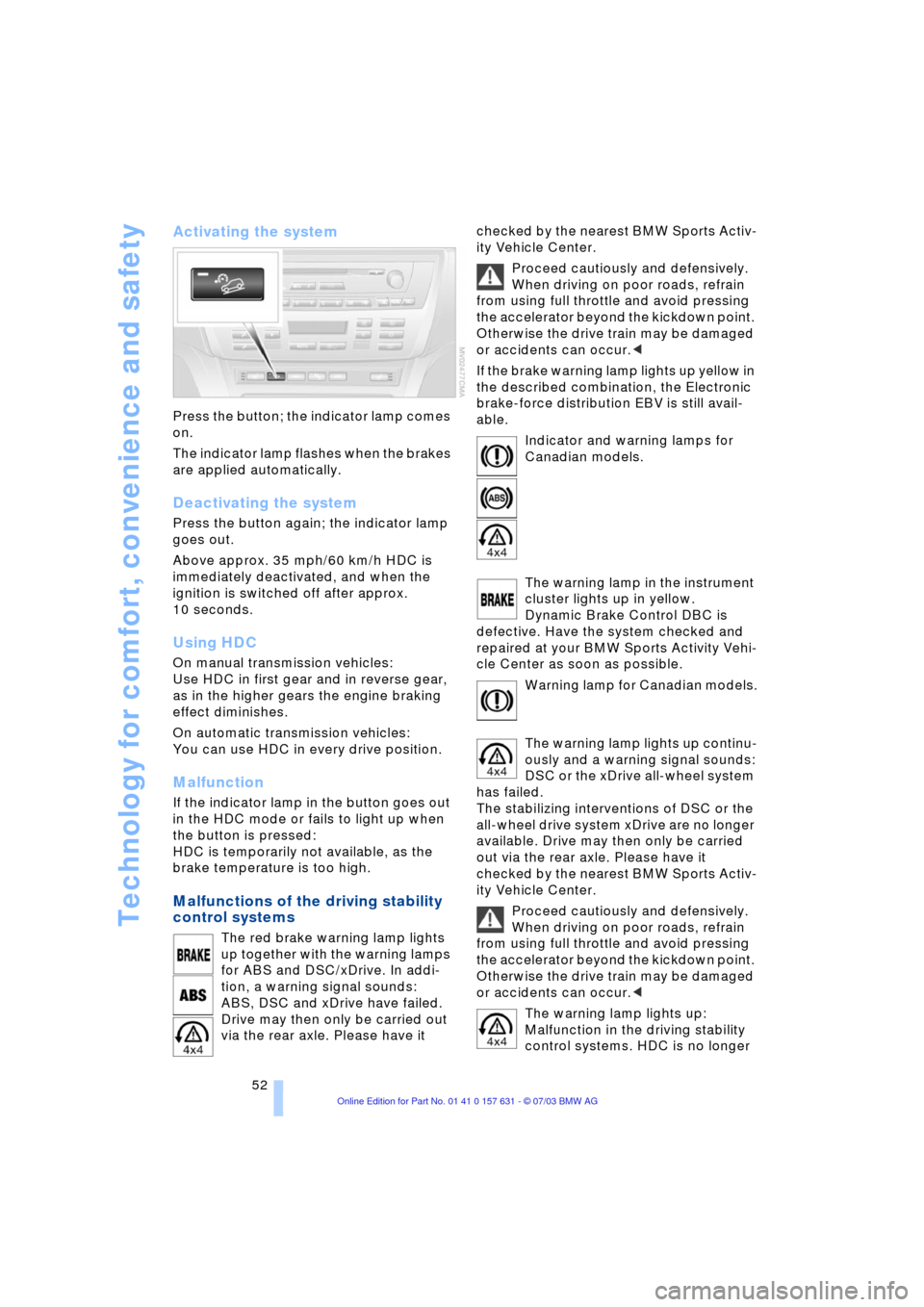
Technology for comfort, convenience and safety
52
Activating the system
Press the button; the indicator lamp comes
on.
The indicator lamp flashes when the brakes
are applied automatically.
Deactivating the system
Press the button again; the indicator lamp
goes out.
Above approx. 35 mph/60 km/h HDC is
immediately deactivated, and when the
ignition is switched off after approx.
10 seconds.
Using HDC
On manual transmission vehicles:
Use HDC in first gear and in reverse gear,
as in the higher gears the engine braking
effect diminishes.
On automatic transmission vehicles:
You can use HDC in every drive position.
Malfunction
If the indicator lamp in the button goes out
in the HDC mode or fails to light up when
the button is pressed:
HDC is temporarily not available, as the
brake temperature is too high.
Malfunctions of the driving stability
control systems
The red brake warning lamp lights
up together with the warning lamps
for ABS and DSC/xDrive. In addi-
tion, a warning signal sounds:
ABS, DSC and xDrive have failed.
Drive may then only be carried out
via the rear axle. Please have it checked by the nearest BMW Sports Activ-
ity Vehicle Center.
Proceed cautiously and defensively.
When driving on poor roads, refrain
from using full throttle and avoid pressing
the accelerator beyond the kickdown point.
Otherwise the drive train may be damaged
or accidents can occur.<
If the brake warning lamp lights up yellow in
the described combination, the Electronic
brake-force distribution EBV is still avail-
able.
Indicator and warning lamps for
Canadian models.
The warning lamp in the instrument
cluster lights up in yellow.
Dynamic Brake Control DBC is
defective. Have the system checked and
repaired at your BMW Sports Activity Vehi-
cle Center as soon as possible.
Warning lamp for Canadian models.
The warning lamp lights up continu-
ously and a warning signal sounds:
DSC or the xDrive all-wheel system
has failed.
The stabilizing interventions of DSC or the
all-wheel drive system xDrive are no longer
available. Drive may then only be carried
out via the rear axle. Please have it
checked by the nearest BMW Sports Activ-
ity Vehicle Center.
Proceed cautiously and defensively.
When driving on poor roads, refrain
from using full throttle and avoid pressing
the accelerator beyond the kickdown point.
Otherwise the drive train may be damaged
or accidents can occur.<
The warning lamp lights up:
Malfunction in the driving stability
control systems. HDC is no longer
Page 92 of 132

Wheels and tires
90 with specialized knowledge and corre-
sponding equipment.<
The correct wheel and tire combination
affects various systems whose function
would otherwise be impaired, e.g. ABS,
DSC or xDrive.
Have the wheel and tire assemblies bal-
anced every time either a wheel or a tire is
replaced.
BMW does not recommend the use of
retreaded tires, as otherwise driving
safety may be reduced. Possible variations
in the design and the age Ð which could be
substantial Ð of the carcasses can lead to
unusually rapid wear.<
The right wheels and tires
BMW recommends that you use only
wheel and tire combinations that
BMW has tested and approved for your
particular vehicle. Variations in factors such
as manufacturing tolerances mean that
even wheels and tires with identical official
size ratings could actually have different
dimensions than the approved units Ð these
differences could lead to body contact, and
with it the risk of severe accidents. If non-
approved wheels and tires are used, BMW
cannot evaluate their suitability, and there-
fore cannot be held liable for driving
safety.<
To maintain good handling and vehicle
response, use only tires of a single tread
configuration from a single manufacturer.
After a flat tire, always remember to have
the specified wheel and tire combination
remounted on the vehicle as soon as pos-
sible.
Recommended tire brands
BMW tests certain tire brands for each tire
size, classifies them as road-safe and
approves them. You can obtain a list of
these from your BMW Sports Activity Vehi-
cle Center. Observe any country-specific
regulations, e.g. on making a correspond-
ing entry in the vehicle documents.
The factory-mounted tires have been spe-
cially selected to provide optimized perfor-mance when installed on your vehicle; if
properly cared for, they will provide a com-
bination of safety and excellent ride com-
fort.
Special characteristics of winter
tires
BMW recommends winter tires for use in
cold winter driving conditions. Although all-
season M+S tires provide better winter
traction than summer tires, they generally
fail to provide the same levels of cold-
weather performance as winter tires.
When switching to winter tires, observe the
descriptions at Tire condition and Replac-
ing wheels/tires, refer to page 89.
Observing speed ratings
Never exceed the maximum speed for
which the winter tires are rated.
Unprofessional attempts by laymen to ser-
vice tires can lead to damage and acci-
dents. Have this work performed by skilled
professionals only. The technicians at your
BMW Sports Activity Vehicle Center will be
glad to assist you with the required profes-
sional knowledge and specialized equip-
ment.<
Storage
Store wheels or tires in a cool, dry place,
protecting them against light whenever
possible. Protect the tires against contact
with oil, grease and fuel.
Do not exceed the maximum tire inflation
pressure specified on the side of the tire.
Snow chains*
Do not exceed a vehicle speed of
30 mph/50 km/h with snow chains
mounted.<
Only certain snow chains have been tested
by BMW and classified and approved as
safe. You can obtain a list of these from
your BMW Sports Activity Vehicle Center.
BMW recommends the use of approved
narrow-link snow chains only. These snow
chains are approved exclusively for use on
Page 93 of 132

Reference
At a glance
Controls
Driving tips
Mobility
91
summer or winter tires in pairs on the rear
wheels.
Observe the manufacturer's instructions
when installing snow chains.
After mounting snow chains, do not
initialize the Flat Tire Monitor.
When you are driving with snow chains, it
can be beneficial to switch off DSC briefly,
refer to page 51.<
Page 107 of 132
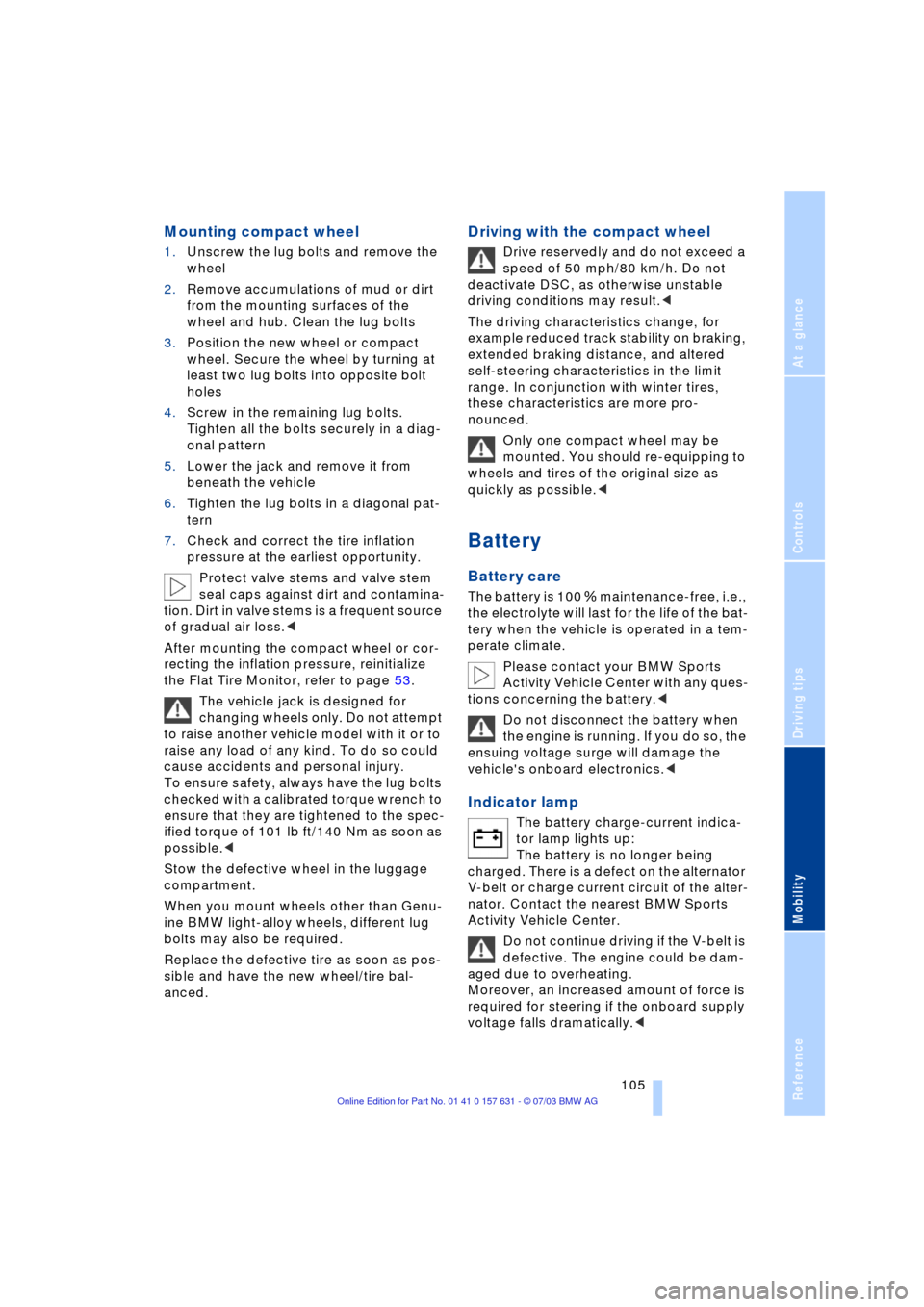
Reference
At a glance
Controls
Driving tips
Mobility
105
Mounting compact wheel
1.Unscrew the lug bolts and remove the
wheel
2.Remove accumulations of mud or dirt
from the mounting surfaces of the
wheel and hub. Clean the lug bolts
3.Position the new wheel or compact
wheel. Secure the wheel by turning at
least two lug bolts into opposite bolt
holes
4.Screw in the remaining lug bolts.
Tighten all the bolts securely in a diag-
onal pattern
5.Lower the jack and remove it from
beneath the vehicle
6.Tighten the lug bolts in a diagonal pat-
tern
7.Check and correct the tire inflation
pressure at the earliest opportunity.
Protect valve stems and valve stem
seal caps against dirt and contamina-
tion. Dirt in valve stems is a frequent source
of gradual air loss.<
After mounting the compact wheel or cor-
recting the inflation pressure, reinitialize
the Flat Tire Monitor, refer to page 53.
The vehicle jack is designed for
changing wheels only. Do not attempt
to raise another vehicle model with it or to
raise any load of any kind. To do so could
cause accidents and personal injury.
To ensure safety, always have the lug bolts
checked with a calibrated torque wrench to
ensure that they are tightened to the spec-
ified torque of 101 lb ft/140 Nm as soon as
possible.<
Stow the defective wheel in the luggage
compartment.
When you mount wheels other than Genu-
ine BMW light-alloy wheels, different lug
bolts may also be required.
Replace the defective tire as soon as pos-
sible and have the new wheel/tire bal-
anced.
Driving with the compact wheel
Drive reservedly and do not exceed a
speed of 50 mph/80 km/h. Do not
deactivate DSC, as otherwise unstable
driving conditions may result.<
The driving characteristics change, for
example reduced track stability on braking,
extended braking distance, and altered
self-steering characteristics in the limit
range. In conjunction with winter tires,
these characteristics are more pro-
nounced.
Only one compact wheel may be
mounted. You should re-equipping to
wheels and tires of the original size as
quickly as possible.<
Battery
Battery care
The battery is 100% maintenance-free, i.e.,
the electrolyte will last for the life of the bat-
tery when the vehicle is operated in a tem-
perate climate.
Please contact your BMW Sports
Activity Vehicle Center with any ques-
tions concerning the battery.<
Do not disconnect the battery when
the engine is running. If you do so, the
ensuing voltage surge will damage the
vehicle's onboard electronics.<
Indicator lamp
The battery charge-current indica-
tor lamp lights up:
The battery is no longer being
charged. There is a defect on the alternator
V-belt or charge current circuit of the alter-
nator. Contact the nearest BMW Sports
Activity Vehicle Center.
Do not continue driving if the V-belt is
defective. The engine could be dam-
aged due to overheating.
Moreover, an increased amount of force is
required for steering if the onboard supply
voltage falls dramatically.<
Page 123 of 132

Reference
At a glance
Controls
Driving tips
Mobility
121
Coolant 95
Ð indicator lamp 95
Ð level 96
Ð temperature gauge 45
Coolant temperature
gauge 45
Cooling, refer to
Temperature 61
Copyright 2
Cruise control
Ð buttons in steering
wheel 14
Ð indicator lamp 43
Cruise control, refer to
Ð Programmable cruise
control 43
Cruising range 48
Cup holder, refer to
Beverage holders 67
Curb weight 116
Cylinders, refer to Engine
data 114
D
Dashboard system, refer to
Cockpit 10
Data, technical
Ð dimensions 115
Ð engine 114
Ð filling capacities 117
Ð weights 116
Daytime driving lamp 57
DBC Dynamic Brake
Control 50
Ð indicator lamp 50
Decommissioning the
vehicle, refer to Caring for
your vehicle brochure 97
Defect, refer to Manual
operation
Defects 7
Defrosting, windows 61
Ð air conditioner 62
Ð automatic climate
control 64
Ð rear window
defroster 61, 65Defrosting windows and
removing condensation
Ð air conditioner 62
Ð automatic climate
control 64
Defrosting windshield, refer
to Defrosting
windows 62, 64
Defrost position, refer to
Defrosting
windows 62, 64
Digital clock 46
Dimensions 115
Dipstick, engine oil 94
Directional indicators, refer
to Turn signal
indicators 41
Discs brakes 76, 77
Displacement, refer to
Engine data 114
Display lighting, refer to
Instrument lighting 58
Displays, refer to
Instrument
cluster 11
Disposal
Ð batteries 106
Ð oil 95
Doors
Ð locking and unlocking 20
Ð manual operation 20
DOT Quality Grades 88
Draft-free ventilation 61, 65
Drawbar support load 116
Driving lamps, refer to
Parking lamps/low
beams 57
Driving notes 76
Driving on bad roads 80
Driving stability control
systems 50
Driving through water 80
DSC Dynamic Stability
Control 50
Ð indicator lamp 51
E
Electrical malfunction
Ð door lock 20
Ð doors 20
Ð driver's door 20
Ð fuel filler door 84
Ð panorama glass roof 24
Ð tailgate 21
Electric power windows 22
Electronic Stability
Program ESP, refer to
Dynamic Stability
Control 50
Emergency actuation, refer
to Manual operation
Emergency call 107
Engine
Ð breaking in 76
Ð data 114
Ð indicator lamp 37
Ð malfunction in electronic
circuitry 38
Ð speed 45
Engine compartment 93
Engine coolant 95
Engine hood 92
Engine oil 95
Ð indicator/warning
lamp 94
Ð prescribed oils 95
Engine oil grades 95
Engine oil level 94
Ð indicator/warning
lamp 94
Engine oil pressure 94
Ð indicator/warning
lamp 94
Engine oil sensor 94
Ð indicator/warning
lamp 94
Engine output, refer to
Engine data 114
Engine temperature, refer
to Coolant
temperature 45
Equipment range, refer to
Service and Warranty
Information Booklet for
Page 124 of 132
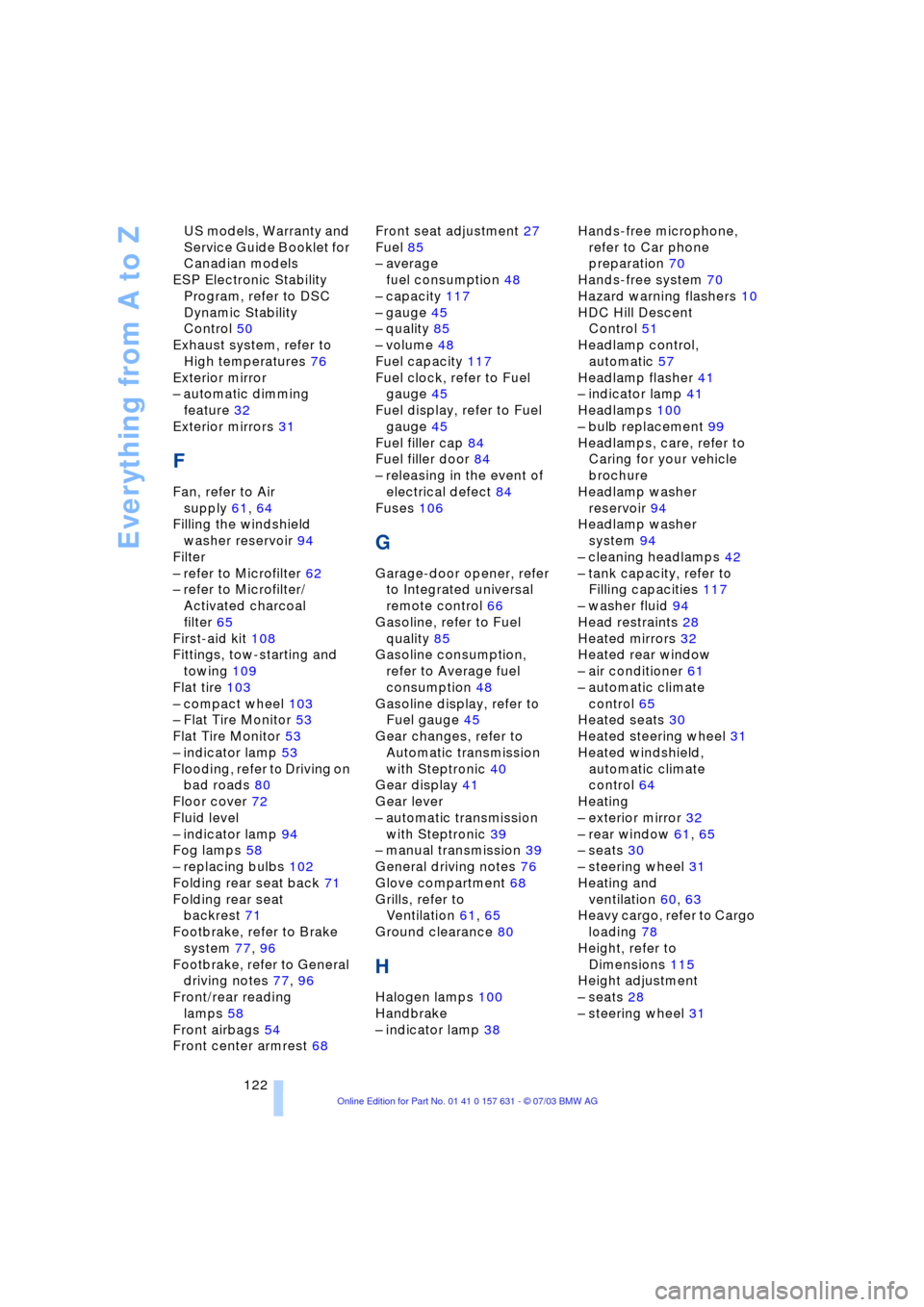
Everything from A to Z
122 US models, Warranty and
Service Guide Booklet for
Canadian models
ESP Electronic Stability
Program, refer to DSC
Dynamic Stability
Control 50
Exhaust system, refer to
High temperatures 76
Exterior mirror
Ð automatic dimming
feature 32
Exterior mirrors 31
F
Fan, refer to Air
supply 61, 64
Filling the windshield
washer reservoir 94
Filter
Ð refer to Microfilter 62
Ð refer to Microfilter/
Activated charcoal
filter 65
First-aid kit 108
Fittings, tow-starting and
towing 109
Flat tire 103
Ð compact wheel 103
Ð Flat Tire Monitor 53
Flat Tire Monitor 53
Ð indicator lamp 53
Flooding, refer to Driving on
bad roads 80
Floor cover 72
Fluid level
Ð indicator lamp 94
Fog lamps 58
Ð replacing bulbs 102
Folding rear seat back 71
Folding rear seat
backrest 71
Footbrake, refer to Brake
system 77, 96
Footbrake, refer to General
driving notes 77, 96
Front/rear reading
lamps 58
Front airbags 54
Front center armrest 68Front seat adjustment 27
Fuel 85
Ð average
fuel consumption 48
Ð capacity 117
Ð gauge 45
Ð quality 85
Ð volume 48
Fuel capacity 117
Fuel clock, refer to Fuel
gauge 45
Fuel display, refer to Fuel
gauge 45
Fuel filler cap 84
Fuel filler door 84
Ð releasing in the event of
electrical defect 84
Fuses 106
G
Garage-door opener, refer
to Integrated universal
remote control 66
Gasoline, refer to Fuel
quality 85
Gasoline consumption,
refer to Average fuel
consumption 48
Gasoline display, refer to
Fuel gauge 45
Gear changes, refer to
Automatic transmission
with Steptronic 40
Gear display 41
Gear lever
Ð automatic transmission
with Steptronic 39
Ð manual transmission 39
General driving notes 76
Glove compartment 68
Grills, refer to
Ventilation 61, 65
Ground clearance 80
H
Halogen lamps 100
Handbrake
Ð indicator lamp 38Hands-free microphone,
refer to Car phone
preparation 70
Hands-free system 70
Hazard warning flashers 10
HDC Hill Descent
Control 51
Headlamp control,
automatic 57
Headlamp flasher 41
Ð indicator lamp 41
Headlamps 100
Ð bulb replacement 99
Headlamps, care, refer to
Caring for your vehicle
brochure
Headlamp washer
reservoir 94
Headlamp washer
system 94
Ð cleaning headlamps 42
Ð tank capacity, refer to
Filling capacities 117
Ð washer fluid 94
Head restraints 28
Heated mirrors 32
Heated rear window
Ð air conditioner 61
Ð automatic climate
control 65
Heated seats 30
Heated steering wheel 31
Heated windshield,
automatic climate
control 64
Heating
Ð exterior mirror 32
Ð rear window 61, 65
Ð seats 30
Ð steering wheel 31
Heating and
ventilation 60, 63
Heavy cargo, refer to Cargo
loading 78
Height, refer to
Dimensions 115
Height adjustment
Ð seats 28
Ð steering wheel 31
Page 125 of 132
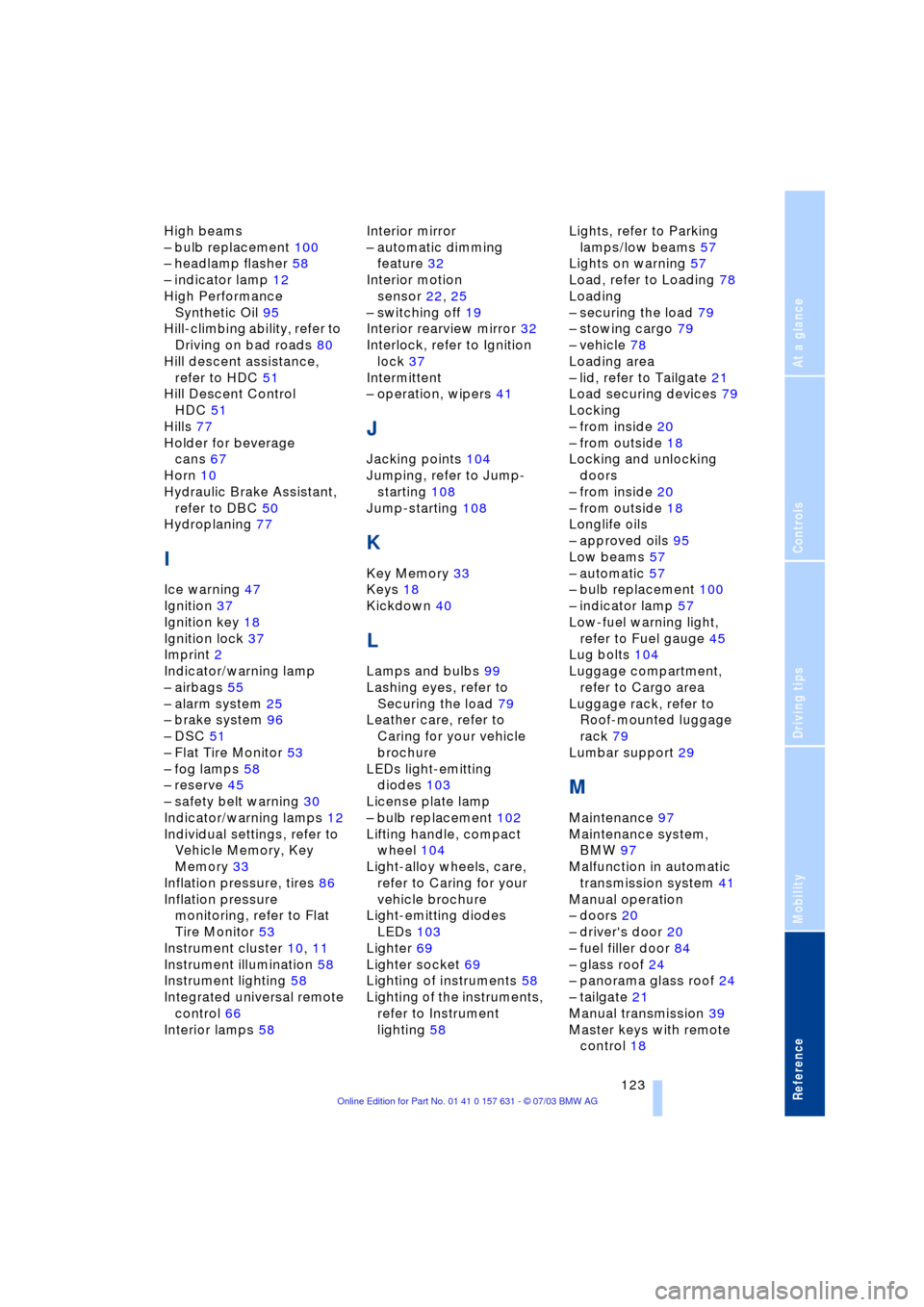
Reference
At a glance
Controls
Driving tips
Mobility
123
High beams
Ð bulb replacement 100
Ð headlamp flasher 58
Ð indicator lamp 12
High Performance
Synthetic Oil 95
Hill-climbing ability, refer to
Driving on bad roads 80
Hill descent assistance,
refer to HDC 51
Hill Descent Control
HDC 51
Hills 77
Holder for beverage
cans 67
Horn 10
Hydraulic Brake Assistant,
refer to DBC 50
Hydroplaning 77
I
Ice warning 47
Ignition 37
Ignition key 18
Ignition lock 37
Imprint 2
Indicator/warning lamp
Ð airbags 55
Ð alarm system 25
Ð brake system 96
Ð DSC 51
Ð Flat Tire Monitor 53
Ð fog lamps 58
Ð reserve 45
Ð safety belt warning 30
Indicator/warning lamps 12
Individual settings, refer to
Vehicle Memory, Key
Memory 33
Inflation pressure, tires 86
Inflation pressure
monitoring, refer to Flat
Tire Monitor 53
Instrument cluster 10, 11
Instrument illumination 58
Instrument lighting 58
Integrated universal remote
control 66
Interior lamps 58Interior mirror
Ð automatic dimming
feature 32
Interior motion
sensor 22, 25
Ð switching off 19
Interior rearview mirror 32
Interlock, refer to Ignition
lock 37
Intermittent
Ð operation, wipers 41
J
Jacking points 104
Jumping, refer to Jump-
starting 108
Jump-starting 108
K
Key Memory 33
Keys 18
Kickdown 40
L
Lamps and bulbs 99
Lashing eyes, refer to
Securing the load 79
Leather care, refer to
Caring for your vehicle
brochure
LEDs light-emitting
diodes 103
License plate lamp
Ð bulb replacement 102
Lifting handle, compact
wheel 104
Light-alloy wheels, care,
refer to Caring for your
vehicle brochure
Light-emitting diodes
LEDs 103
Lighter 69
Lighter socket 69
Lighting of instruments 58
Lighting of the instruments,
refer to Instrument
lighting 58Lights, refer to Parking
lamps/low beams 57
Lights on warning 57
Load, refer to Loading 78
Loading
Ð securing the load 79
Ð stowing cargo 79
Ð vehicle 78
Loading area
Ð lid, refer to Tailgate 21
Load securing devices 79
Locking
Ð from inside 20
Ð from outside 18
Locking and unlocking
doors
Ð from inside 20
Ð from outside 18
Longlife oils
Ð approved oils 95
Low beams 57
Ð automatic 57
Ð bulb replacement 100
Ð indicator lamp 57
Low-fuel warning light,
refer to Fuel gauge 45
Lug bolts 104
Luggage compartment,
refer to Cargo area
Luggage rack, refer to
Roof-mounted luggage
rack 79
Lumbar support 29
M
Maintenance 97
Maintenance system,
BMW 97
Malfunction in automatic
transmission system 41
Manual operation
Ð doors 20
Ð driver's door 20
Ð fuel filler door 84
Ð glass roof 24
Ð panorama glass roof 24
Ð tailgate 21
Manual transmission 39
Master keys with remote
control 18